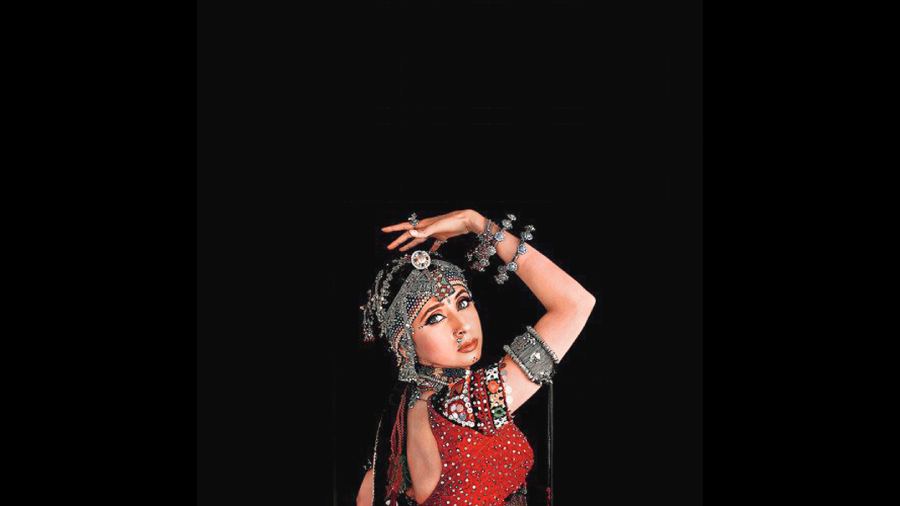Item numbers have pervaded popular Indian cinema. Urmila Matondkar’s “Chamma Chamma” in China Gate, “Manohari” in Bahubali, “Oo Bolega ya” in Pushpa — each of these performances immediately captured the audience’s attention. They also revealed a morally ambivalent attitude amongst viewers. Some aspects of this ambivalence are decoded here by focusing on the structural elements and the bracketing of the emotional factors that prevail on the outer layer of the ‘item number’.
One way of highlighting the structural elements would be to imagine a triangle among the item number, the two-heroine formula and the vamp. These developments came about at various stages on a not-so-linear timeline. The item number was preceded by the two-heroine model, which was preceded by that of the vamp. The item number is distinct from the roles of both the vamp and the two heroines. The vamp’s role was marginal to the film, even though it was often played by popular actors such as Helen. Like the vamp, the item number, too, is located on the margins of the film. Despite both roles being limited spatially and temporally, the item number enjoys a prominence that was not accorded to the vamp. With leading heroines often performing the numbers, it draws equal importance, both in terms of casting and remuneration.
As a prelude to discussing the relationship between the item number and the two-heroine formula, I would like to mention the suicide of Silk Smitha, a well-known, popular dancer from South India known for playing the vamp. Her tragic suicide symbolized the exit of the vamp from Indian cinema. The role of the vamp was to allure and seduce, a task that was not thought proper for the heroine who had to appear chaste. The vamp was replaced by the two-heroine model in which not one but two women were required to fill in the role. Dream sequences were introduced with seductive dances to give the viewers the titillation that the vamp had so far extended.
Both the heroines were not seen simultaneously on-screen with the hero. The exit of the first heroine made way for the entry of the second heroine. This was how popular cinema in the latter part of the last century facilitated the polygynous combination of two heroines with one hero. The practice of polygyny is banned by Indian law. That which is rejected in reality was smuggled in and presented in a provocative, seemingly more palatable, manner through cinema. The corruption of the mind replaced the corruption of the body.
However, the two-heroine-one-hero combination gradually started pricking the moral consciousness of viewers. The hero, who traditionally commands the audience’s loyalty, is usually expected to be morally upright and worth emulating. But the hero’s seemingly polygynous behaviour led to confusion amongst viewers. Thus, this formula was discontinued and was replaced by the item number.
The item number is prominent even while remaining at the margins of the film. This strange combination disturbs the centre-periphery relations, thereby creating ambivalence and unease amongst the viewers. There is a need to explore other domains to understand this ambivalence.
The domain that I find interesting is the domain of the body. I distinguish between the body as personal and the body as professional. Heroines — whether first or second — and vamps have physical relationships with the hero and the villain, respectively. This physical relationship is reflected throughout the film. In stark contrast, the absence of any physical relationship defines the item number. Leaving aside the physical aspect of the body, I would like to explore the other element — namely the body as professional — to understand the item number.
The item number is professional. It usually bears no direct relevance to the plot despite being featured prominently in the middle of the film. While its essential purpose is to be titillating, it is also isolated from the personal domain of the hero or the villain. This physical distancing safeguards the moral status of the hero. Unlike heroines or vamps, the item number dancer allows her body to be used only for the professional purpose of dancing and entertainment. She guards her body against any encroachment into the personal domain.
I arrived at this structural aspect by bracketing the emotive aspects and distinguishing between the body as personal and as physical. I find the item number to be unique and creative — qualities that need not be the monopoly of the morally upright. While the uniqueness may or may not be an intended consequence, the item number displays both professional and technical excellence that allow it to negotiate the underlying moral subversion skilfully.
These structural aspects — as revealed through the triangle — provide for aesthetic grammar. One may reject the item number on moral grounds but not before identifying these architectural features. While being immensely popular, Katrina Kaif’s “Sheila ki Jawani” in Tees Maar Khan is not strictly an item number as she plays a role in the overall plot. However, her relationship with the titular character is inconclusive, unlike with heroines in most mainstream films.
Here my analysis is philosophical and conceptual. I am only highlighting structural aspects where creativity lies outside what is morally correct. It also reveals the changing nature of public tastes catered to by popular films. Even if one does not morally endorse the racy nature of the item number, it is necessary not to lose sight of the structural dimensions and the professional excellence of this unique feature of Indian cinema.
( A. Raghuramaraju teaches philosophy at the Indian Institute of Technology Tirupati)











